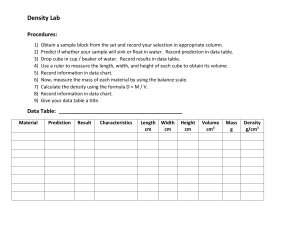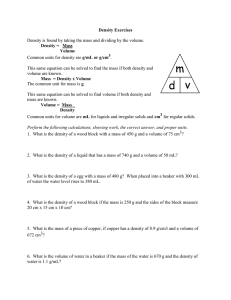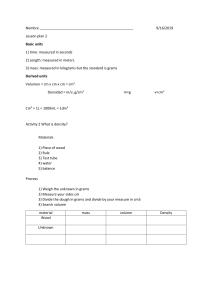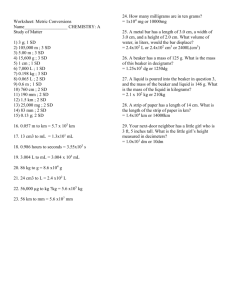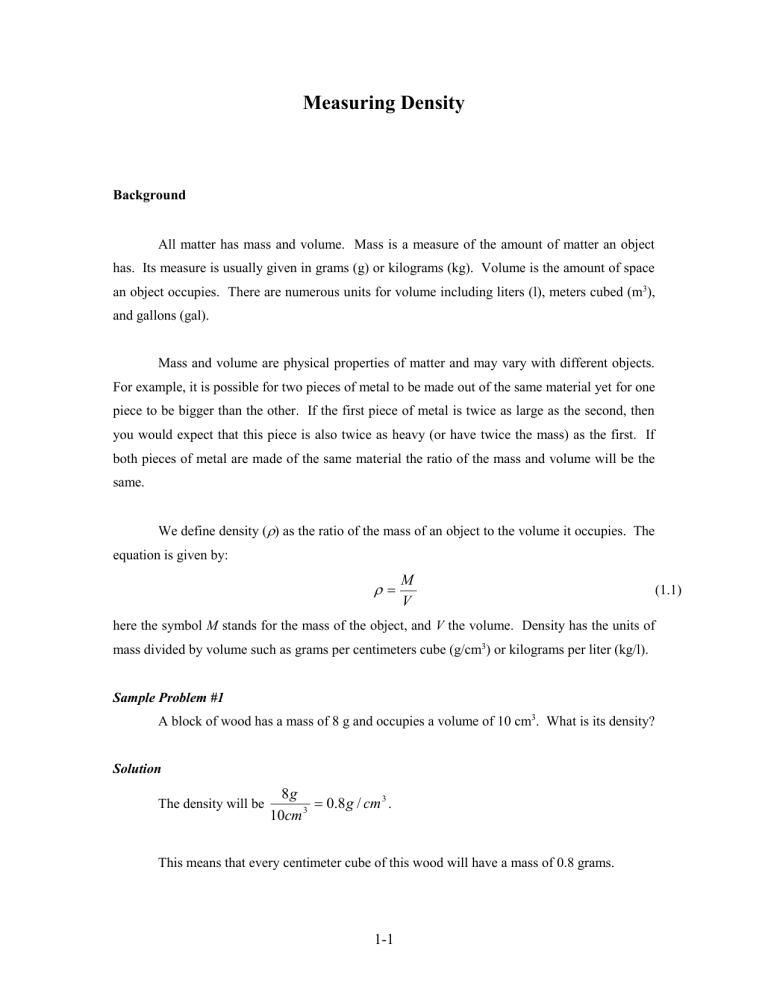
Measuring Density Background All matter has mass and volume. Mass is a measure of the amount of matter an object has. Its measure is usually given in grams (g) or kilograms (kg). Volume is the amount of space an object occupies. There are numerous units for volume including liters (l), meters cubed (m3), and gallons (gal). Mass and volume are physical properties of matter and may vary with different objects. For example, it is possible for two pieces of metal to be made out of the same material yet for one piece to be bigger than the other. If the first piece of metal is twice as large as the second, then you would expect that this piece is also twice as heavy (or have twice the mass) as the first. If both pieces of metal are made of the same material the ratio of the mass and volume will be the same. We define density () as the ratio of the mass of an object to the volume it occupies. The equation is given by: M V here the symbol M stands for the mass of the object, and V the volume. Density has the units of mass divided by volume such as grams per centimeters cube (g/cm3) or kilograms per liter (kg/l). Sample Problem #1 A block of wood has a mass of 8 g and occupies a volume of 10 cm3. What is its density? Solution The density will be 8g 0.8 g / cm 3 . 3 10cm This means that every centimeter cube of this wood will have a mass of 0.8 grams. 1-1 (1.1) Activity 1: (Determine the density of an object with a regular shape.) Obtain a set of objects (cube, cylinder, sphere, etc.) made of the same material. Calculate the density by measuring the mass and volume of your samples. Measuring the Mass Measure the mass of your samples using the triple beam balance provided. You will make this measurement three times and calculate the average. Record your results in the table below. Trial Sample 1 Sample 2 1 2 3 Avg. Measuring the Volume To determine the volume of an object with a regular shape there are standard equations that may be used. The equations for three common shapes are given below. Sphere V 4 R3 3 Cube Cylinder V L W H V 4 R2 H Measure the relevant dimensions of your sample and record the reading in the tables below. 1-2 (1.2) Sample #1 Trial Length (cm) Width (cm) Height (cm) 1 2 3 Avg. Calculate the volume of Sample #1 using equations (1.2). Show all work Volume = ____________________________________________________. Sample #2 Trial 1 2 3 Avg. Calculate the volume for Sample #2. Show all work Volume = ____________________________________________________. Calculate the Density Specimen Volume (cm3) Mass (grams) 1-3 Density (gm/cm3) Even though both object have different shape and volume what did you observe about the density of the samples: ___________________________________________________________ Unlike the mass and volume that may be different for each specimen, all objects made of the same material will have the same density. Because of this the density is often used to identify unknown substances or to determine the percent composition. The densities of various substances are given in Table 1. Solids Lead Silver Copper Brass Nickel Iron Aluminum Marble Granite Rubber Oak Pine Density 11.373) (g/cm 10.57 8.92 8.90 8.57 7.90 2.67 2.60 – 2.84 2.65 1.10 – 1.19 0.80 0.35 – 0.50 Table 1. Density of solid substances. Densities are in g/cm3. Sample Problem #2 A block of wood has a mass of 4 g and occupies a volume of 5 cm3. What type of wood can it be? Solution The density will be 4g 0.8 g / cm 3 . 5cm 3 From Table 1 the only wood with that density is Oak. 1-4 Activity 2: (Determine the Density of an object with an irregular shape.) Obtain a set of irregularly shaped samples. Calculate the density by measuring the mass and volume. Measuring the Mass Trial Sample 1 Sample 2 1 2 3 Avg. Measuring the Volume The volume of an irregularly shaped object can be determined by measuring the amount of water it displaces. Fill a graduated cylinder about half way with water. Note the level of the water. Submerge your sample and mark the new water level. Sample 1 Sample 2 Final volume of water Initial volume of water Volume of sample Calculate the Density Specimen Volume (cm3) Mass (grams) 1-5 Density (gm/cm3) Activity 3: (Determine the Density of a liquid) Calculate the density by measuring the mass and volume of your liquid sample. Measure the Mass Trial Sample 1 1 2 3 Avg. Measure the Volume Trial Sample 1 Volume Calculate the Density Specimen Volume (cm3) Mass (grams) Density (gm/cm3) Density (g/cm3) Liquids Mercury Glycerine Milk Sea Water Water Alcohol Gasoline 13.60 1.26 1.03 1.02 1.00 0.79 0.67 Table 2. Density of some liquid substances. Densities are in g/cm3. What is the composition of the liquid sample? ____________________________________ 1-6 Activity 4: (Determine the Density of a Gas) A gas can be compressed so the density of a gas can change. 1. Place a beaker inside a bath filled with water so that the beaker is about ½ filled with water and the other ½ air. (you might have to let some air out by tilting the beaker.) 2. Add water to the bath. a. What happens to the water level inside the beaker? ___________________ b. Has any air escaped the beaker? Has the amount of air inside the beaker changed? __________________________________________________ c. What happens to the density of the air inside the beaker when you add the water? ____________________________________________________ 1-7


